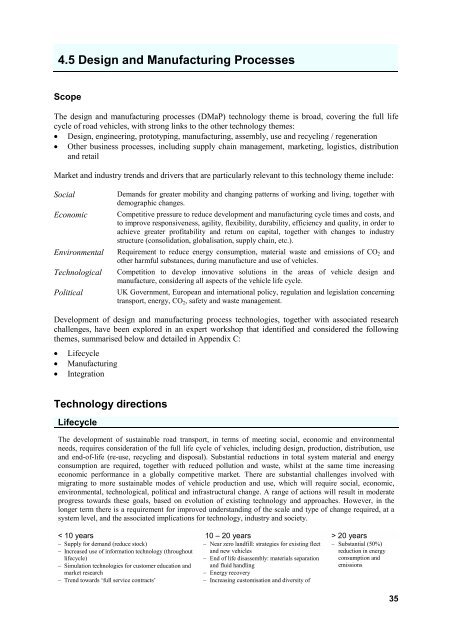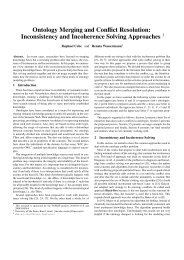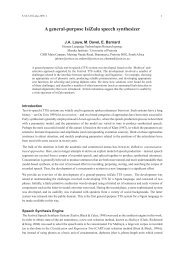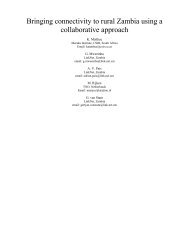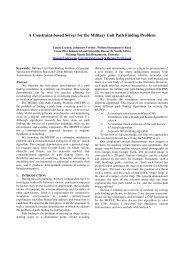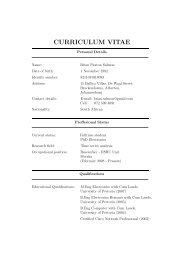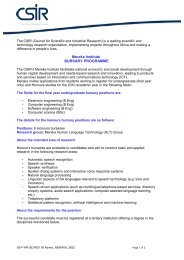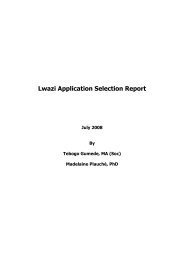4.5 Design and <strong>Manufacturing</strong> ProcessesScopeThe design and manufacturing processes (DMaP) technology theme is broad, covering the full lifecycle of road vehicles, with strong links to the other technology themes: Design, engineering, prototyping, manufacturing, assembly, use and recycling / regeneration Other business processes, including supply chain management, marketing, logistics, distributionand retailMarket and industry trends and drivers that are particularly relevant to this technology theme include:SocialEconomicEnvironmentalTechnologicalPoliticalDemands <strong>for</strong> greater mobility and changing patterns of working and living, together withdemographic changes.Competitive pressure to reduce development and manufacturing cycle times and costs, andto improve responsiveness, agility, flexibility, durability, efficiency and quality, in order toachieve greater profitability and return on capital, together with changes to industrystructure (consolidation, globalisation, supply chain, etc.).Requirement to reduce energy consumption, material waste and emissions of CO 2 andother harmful substances, during manufacture and use of vehicles.Competition to develop innovative solutions in the areas of vehicle design andmanufacture, considering all aspects of the vehicle life cycle.UK Government, European and international policy, regulation and legislation concerningtransport, energy, CO 2 , safety and waste management.Development of design and manufacturing process technologies, together with associated researchchallenges, have been explored in an expert workshop that identified and considered the followingthemes, summarised below and detailed in Appendix C:Lifecycle<strong>Manufacturing</strong>Integration<strong>Technology</strong> directionsLifecycleThe development of sustainable road transport, in terms of meeting social, economic and environmentalneeds, requires consideration of the full life cycle of vehicles, including design, production, distribution, useand end-of-life (re-use, recycling and disposal). Substantial reductions in total system material and energyconsumption are required, together with reduced pollution and waste, whilst at the same time increasingeconomic per<strong>for</strong>mance in a globally competitive market. There are substantial challenges involved withmigrating to more sustainable modes of vehicle production and use, which will require social, economic,environmental, technological, political and infrastructural change. A range of actions will result in moderateprogress towards these goals, based on evolution of existing technology and approaches. However, in thelonger term there is a requirement <strong>for</strong> improved understanding of the scale and type of change required, at asystem level, and the associated implications <strong>for</strong> technology, industry and society.< 10 years 10 – 20 years > 20 years Supply <strong>for</strong> demand (reduce stock) Increased use of in<strong>for</strong>mation technology (throughoutlifecycle) Simulation technologies <strong>for</strong> customer education andmarket research Trend towards ‘full service contracts’ Near zero landfill: strategies <strong>for</strong> existing fleetand new vehicles End of life disassembly: materials separationand fluid handling Energy recovery Increasing customisation and diversity of Substantial (50%)reduction in energyconsumption andemissions35
Increase in recycling and re-use Improved understanding and measurement of energy,material and pollution in production and use Development of scenarios and strategies <strong>for</strong>sustainable vehicle systems (personal andcommercial) Improved understanding of social attitudes and needs No or low paint systemsproducts, flexibility and agility of productionsystems New materials and production technologies Changing business models (production andownership)<strong>Manufacturing</strong>Improved manufacturing systems are crucial <strong>for</strong> achieving the social, economic and environmental goalsdescribed above, in terms of reducing energy and material consumption, reducing emissions, and increasingefficiency and competitiveness. Aspects that require attention include component-level manufacture andassembly, system-level manufacture and organisation, management of manufacturing systems, together withcommercial and market considerations. Trends towards greater vehicle variety and customisation, togetherwith increasing rates of innovation and technology development, will demand greater flexibility and agilityfrom manufacturing systems whilst simultaneously improving economic and environmental per<strong>for</strong>mance.< 10 years 10 – 20 years > 20 years Modular construction Design <strong>for</strong> disassembly Rapid joining and disassembly technology Partnerships <strong>for</strong> capital intensive plant and processdevelopment Low capital / cost manufacturing Optimisation of global, regional and local supply Flexible mixed model assembly lines(including supply chain implications) Integrated data exchange (from design todistribution) Rapid prototype manufacture Reconfigurable assembly systems No paint shop vehicles Modular vehicles(with localreconfiguration) Reconfigurablemanufacturing,enabling rapid modelchangeoverchain New vehicle architectures Process energy In-house disposal systems Increasing configuration by dealersreduction Electronic data exchange Reconfiguration tools (low capital cost, rapid Total automated Increasing primary stock yield (metals)part introduction, lower energy)manufacture Reconfigurable jigs New materials (light weight, low cost tooling, Shared production Design tolerance managementefficient & rapid configuration)processes Virtual assembly training Electronic systems integration Small production runs Education and training in new manufacturing Cost effective mass production of advanced (output geared totechnologiescompositesdemand) Virtual design <strong>for</strong> manufacturing plant designand redesignIntegrationSystems integration is crucial if significant improvements to overall life cycle per<strong>for</strong>mance of road vehiclesare to be achieved. This includes consideration of how the various vehicle sub-systems operate together, howthe vehicle is designed, manufactured and operated, and how the in<strong>for</strong>mation and knowledge that enablesthese systems to function can be combined more effectively and efficiently. The challenge will be to increasethe level of integration in the design, manufacture, operation and re-use of vehicle systems in parallel torapidly advancing technology and increasing complexity (engine systems, materials, electronics, software andcommunications), with increasing demand <strong>for</strong> more flexibility, agility and customisation. Standards, opensystems architectures and metrics will need to be established, while at the same time ensuring that creativityand innovation are not compromised. Greater co-operation and collaborative knowledge sharing will berequired, without compromising competitive advantage.< 10 years 10 – 20 years > 20 years Requirements mediation systems Improved in<strong>for</strong>mation flows Increasing involvement of suppliers Increasing onboard monitoring Automated diagnostics, data mining and preventativemaintenance Product and process metrics Increasing use of x-by-wire Open systems architectures Increasing vehicle customisation andadaptability System models to understand tradeoffs andcost implications Incremental vs. radical innovations In<strong>for</strong>mation and knowledge sharing (supplychain, consultants, etc.) Seamless and minimum design cycle Managing in<strong>for</strong>mation overload Economic to producelow vehicle volumes(


